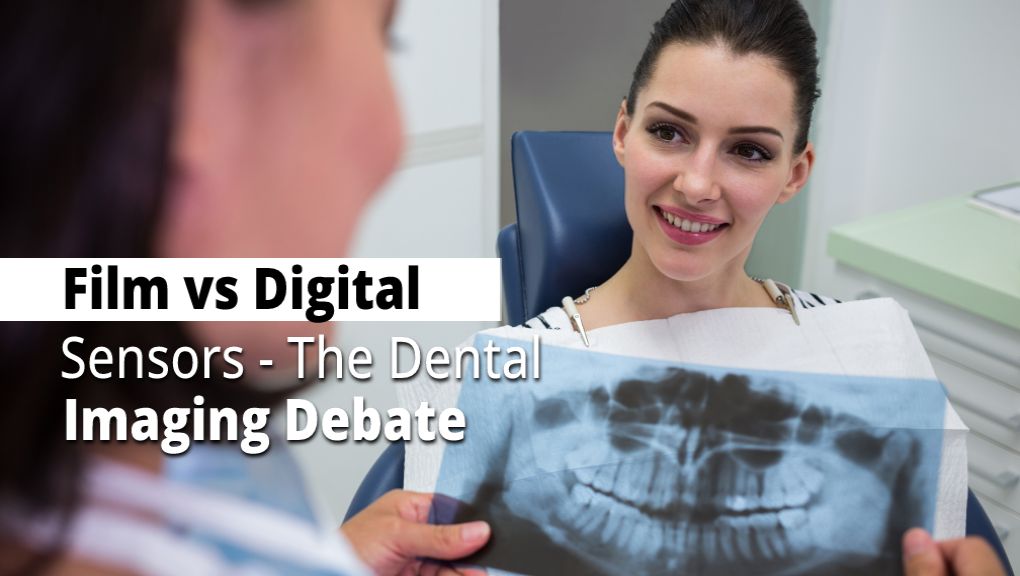
FILM IS BETTER! NO, DIGITAL IS BETTER! Does this sounds like the children fighting as to who’s ice cream is better? Is there proof as to which one is better? As with most things in life, there is always a better option, but the question is at what cost?
Today’s dentists have many options in radiography, but both options are improved once you go digital. Traditional imaging is reliant on an x-ray, film processor, and a viewing window. While this method is still acceptable today, I prefer the higher resolution of digital x-rays to easily diagnose patients. Regardless, we’ll go through the each system.
TRADITIONAL X-RAY FILM:
The benefits of using traditional film based imaging is the low cost to enter (cost of film, x-ray head, developer, and viewing window). Besides the cost for the x-ray head, which you will pay for either way, the cost of film, film developer, and fixer makes this traditional x-rays the most cost effective methods for starting an office. Other benefits of traditional film based x-rays is patient comfort. Film is thin and is generally comfortable for a patient. The downside is the repeated cost for film and film developing chemicals. DentalAssets.com assists with keeping costs low through these options: XRS PREMIUM X-RAY FILM SIZE 2 DOUBLE PACKET D SPEED – 130/box
XRS PREMIUM X-RAY FILM SIZE 2 SINGLE PACKET D SPEED – 150/box
XRS PREMIUM X-RAY FILM SIZE 0 SINGLE PACKET D SPEED – 100/box
XRS PREMIUM X-RAY FILM SIZE 2 SINGLE PACKETS F SPEED – 150/box
XRS PREMIUM X-RAY FILM SIZE 2 DOUBLE PACKET F SPEED – 130/box
XRS PREMIUM X-RAY FILM SIZE 0 SINGLE POCKETS F SPEED – 100/box
Contact [email protected] for other film options.
Although the initial cost isn’t terrible, you are reliant on purchasing x-ray film, and developing chemicals. With each new patient, you use ~18 pieces of film. For ease of calculations, lets round this to 20. If your office has 15 new patients per month, you need 300 pieces of film a month. At a cost of ~$40 per 150 film, your office is spending $80 a month on film alone. With chemical fixers/developer changes occurring once a week (based on patient load), you will go through a gallon of fixer and developer in about a month. With our Ready-to-Use developer costing $9.99/gallon, your office will have an additional cost of $19.98, so approximately $100 a month on x-ray chemicals and film. This is based on the pricing we have available. With other distributors you may be paying much more!
The other detriment to traditional x-rays is image quality. The contrast on the film is based on the chemical you use, x-ray film, x-ray head, and your light source. Luckily, you are able to adjust any contrast issue by using a film digitizer. (XRS QUICKSHOT FIL DIGITIZER). The main benefit of a digitizer is to make the diagnosis process easier for the dentist. You still have the repeated cost of film and fixer.
DIGITAL SENSORS
With a new buildout, instead of purchasing a film developer (XRS ImageMax Automatic Film Processor), you invest in digital sensors. The benefit of utilizing digital sensors is the ease of of diagnosis and no monthly cost of film and chemicals. Patients also benefit with a reduction in x-ray exposure and your office is more technologically advanced.
Unseen costs of digital x-rays are possible monthly costs for imaging software and an increased cost for your x-ray head (DC X-ray head vs AC X-ray Head). DC x-ray heads allow the dentist to fine tune the image quality by adjusting the power and exposure time. DC x-rays heads innovate on how radiation is generated and do not experience the power drop associated with AC style systems. If you are interested in seeing what system is best for your office, contact [email protected].The take away is each imaging sensor requires different radiation to provide a clear image and dentists who have used AC x-rays heads usually have to increase the exposure time to receive clearer images. DC style x-ray heads allow for more adjustability to allow the dentist a better imaging quality.
In regards to patient experience, digital sensors can cause discomfort as they are thicker. For dentists and patients who prefer film based x-rays there are systems, such as Air Techniques ScanX, which use phosphor plates that can be repeatedly used.
The debate between film and digital sensors is a slippery slope as there are many different technologies available for both. You can have many options based on your budget, but recommend going digital as the patient will receive reduced radiation exposures and your office will not have to worry about the cost of film and chemical. You do not have to worry about disposing of x-ray developing chemicals and do not need a dark room. Even if patient comfort is a concern, the digital sensor is used for minimal time and can be sold to the patient with reduced x-ray exposure. If you would like to see what options you have, please contact DentalAssets.com at 949-548-4559 or by contacting [email protected]

17821 E 17th St
Ste 180
Tustin, CA 92780
*Opt-in / Opt-out
**Customers provide their phone number and consent to receive messages via a form on our website